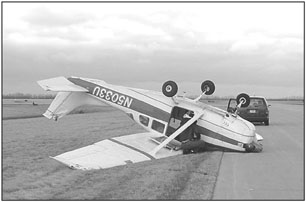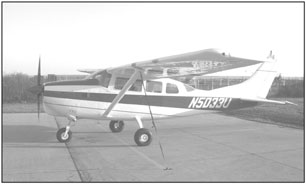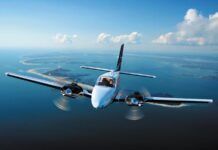
by Clint Lowe
Most owners think about aircraft insurance once a year, when they send in the premium check or maybe chat with a broker about renewal terms. If you never have an accident, thats about as exciting as insurance ought to be.But if the worst happens and you have to ask an insurance company to pay for bent metal, be prepared for some surprises of the unpleasant sort.
Thats what happened to me last year, when the Cessna 206 I used for hauling checks was involved in a freak ground accident that nearly totaled the airplane. In retrospect, much of the expense and downtime I endured might have been avoided if I knew then what I know now.
Im sure some owners reading this will have opinions about the cause and various outcomes that resulted from the incident Ill describe here. Was everything done wrong or just a few things? Even with the clarity of hindsight, Im not sure I can answer that. But I have learned that filing an insurance claim is more complex than I thought and the outcome of the claim may be determined by things that happened before you even bought the airplane.
The Incident
To qualify myself, Im a single-pilot commercial operator. At the time of the incident, I used my Cessna 206 to fly bank checks at night. When I bought the 206, it was the third airplane Id owned following a Cessna 150 and Cessna 172. Id had some small hail claims over the previous 14 years, but nothing substantial and certainly nothing like what followed last Aprils event.
When I bought the 206, it was a pathetic-looking mess doing seasonal skydiving duty at a local club. The airplane was so badly beat up that I quit leasing it to the club after two seasons. Even in such a short time, the new paint had become visibly worn. So I went through the arduous process of getting a Part 135 certificate to earn enough revenue to pay for the airplane and that brings us to the night of the incident.
Shortly before midnight, when Minneapolis Center handed me off to Fargo Approach, Id already listened to ATIS and disengaged altitude hold to begin the VFR descent. Lightning was visible north and east of Fargo, but ATIS had reported nothing unusual. The controller acknowledged my report and said he had just recorded a new ATIS with winds of 30 knots, gusting to 45 knots.This didnt surprise me since Id just landed earlier in similar winds at Bismarck.
During the course of more than 300 trips between the two cities, Id seen just about every kind of weather North Dakota could throw at an airplane.Id retreated on several occasions but with 1700 hours in the 206, high winds were just another thing a freight pilot has to deal with. Although some windshear made the approach interesting, the landing and taxi were routine.
Outbound from Fargo, I cranked up and asked the ground controller what the winds were. He reported that theyd eased; 25 knots gusting to 35. Id just turned onto the taxiway when the controller transmitted, Wow, I just got a gust over 50 knots. This was different. With such unpredictable winds, I decided Id park the plane where Id just come from. Just as I made that decision, a hard gust hit me from a different direction-I later learned it peaked at 55 knots-and I felt the tail and right wing rise. I could tell the right main gear had left the pavement.
Afraid of damaging the engine and prop, I pulled the mixture in one swift motion as the airplane seemed to pause at a 30-degree nose-down angle. It hung there for an eternity, it seemed. I braced for it to fall back on the mains but a second gust hit while it teetered. I became a helpless observer as the taxi light pointed at the scene of the accident. The winding-down prop pounded itself into uselessness and I hung off my seatbelt looking straight down. I killed the engine and master and then, there was silence.
I hung from my seatbelt, feeling for the release and attempting to brace myself by holding my opposite hand on the ceiling. Thud. I found the door release, crawled over the wing and ran from the aircraft a short distance before looking back. The late-night help from the FBO were already running to assist. Shortly, the fire trucks arrived and I rode away from the scene, heartbroken at the sight of my broken airplane.
First Calls
The next morning, I felt fatigued and a little sore but I moved in dazed desperation to get done what needed to be done following the events of the night before. I called the FSDO, whod already found a fax from the tower about the incident. Because it had occurred during ground movement of the airplane, it was incident, not an accident. There would be a few notes to the database but, to my relief, no investigation and no violation.
In the light of day, the damage to the airplane was extensive. The outboard section of the left wing was crumpled from initial contact with the pavement and showed evidence of having crushed rearward as it supported the aircraft on its way over. The prop was bent and abraded and the tail section was buckled and bent with the vertical stabilizer crushed back and downward.The horizontal stabilizer and elevator looked unscathed. The nose bore evidence of abrasion, disfiguring the fiberglass piece below the beat-up nose bowl. The recently-replaced spinner looked like a grotesque accordion, smashed and ground down in spots. It would be three days before the winds abated enough for a crane to right the airplane.
My next stop was my insurance agents office. A fast grapevine had already alerted him to the loss, although the facts were inaccurate. Marc said he wasnt sure how the insurance company would handle the claim, since theyd probably see it as some blatant carelessness of some sort. It turned out that an informant had seen the incident and guessed Id left the airplane on the ramp without tying it down on such a gusty night. After that misinformation was set straight, the claim process went forward.
The insurance adjustor, Matt, arrived a few days later and wandered around the 206, snapping pictures and looking things over. Over lunch, we all thought the airplane would be totaled, principally because everything but the cabin was bent somehow. The engine would have to be torn down for inspection, a new prop installed and a bunch of sheet metal work would be required. We came away from the meeting with me starting to shop for another airplane.
A mechanic from Casselton, a town about 20 miles away, inspected the airplane to work up a repair estimate. Hed done a lot of insurance work and figured the job would take two months to complete, if he put it in hurry-up mode. I still wasnt convinced it was economically repairable. A couple of weeks later a repair estimate materialized: $45,000, plus another $5000 to repair and match the paint.

Totaled? Or Not?
Insurance companies opt for either repair or totaling of an aircraft by comparing the relative cost (to them) of each. For instance, since the 206 was insured for $80,000, if they totaled the airplane theyd have to pay out that amount to the insured. For that check, they acquire the title to the wreckage and then sell it for whatever they can get. In this case, the adjustor informed me that they estimated the airplane would fetch around $17,000 in salvage. So the cost to them if it were totaled would be the $80,000 minus the salvage for a net expense of $63,000.
In the repair scenario, the estimate for repair was $45,000 plus painting. A complete paint job should cost in the neighborhood of $6000 and a repair or paint-matching job should cost something less than that. As it stood, the repair cost looked to be about $50,000 to get back in the air.Repairing the airplane would cost the insurance company $13,000 less, so I was offered two options: one, have the aircraft repaired by the Casselton shop or someone else further away or, two, keep the wrecked airplane and accept a check for $42,000. The third option, totaling it, was dropped.
Insurance policies don’t typically include compensation for lost income, so I was staring a two-month loss of revenue. With the bills still due for payments, fuel burned during the past month, maintenance bills and such, I was devastated. Purchasing another airplane might take a couple of weeks and getting it Part 135-ready might take a few more days. The company I flew for was supportive and promised to take care of the route with their own airplane and pilot until I got mine repaired. The shop came the following week and hauled the 206 away for repairs, assuring me of a turn-key operation in dealing with the insurance company. The shop phoned with periodic updates on progress, but there were some surprises.
Its Not Covered
I soon learned a lesson many have learned before me. While insurance companies are obligated to repair the aircraft to the condition it was before the accident, they wont pay for making the airplane better than it was. This is understandable…mostly.
Here are a couple of examples: Since the crankshaft in my airplane wasnt a Vacuum Arc Re-melt or VAR type, it had to be replaced whether it was damaged or not, according to an AD. The VAR crank, like it or not, is considered a betterment. Right off, I was stuck with a $3000 crankshaft bill. (If the crank had been damaged, it would have been covered.)
Other gotchas surfaced during the course of the repairs. Improper prior repairs in remote portions of the airframe were discovered and had to be fixed. Again, even though these things were not known previously and wouldnt have ever been an issue had the accident not happened, the insurance company doesnt pay for someone elses mistakes. And there were plenty of them.
For instance, the nose gear had collapsed during a hard landing many years before, with only a small note in the logs. The repair was done improperly with the wrong rivets used. This resulted in a labor-expensive replacement of the rivets. Another ding in the wing, which had damaged the rib, had simply been covered up with new sheet metal. The rib replacements added to the cost. All totaled, labor and parts, in addition to what the insurance company would pay for, amounted to a staggering $14,000 in non-covered expenses. I freaked. It got worse.
Paint: Who Pays?
They say communication is everything. With regard to re-painting the airplane, lack of same cost me dearly. With all the repairs made to the airplane, I was concerned about what it would look like with a bunch of matched paint applied over five-year-old polyurethane. Late in the repairs, I was comforted when insurance company saw the wisdom of just painting the entire airplane. It made sense, since the only section not damaged was the cabin. This news came to me via the shop, who said theyd spoken with the adjuster and had it cleared for a complete make-over. Given the circumstances, I had no reason to question him. But something was missed in the conversation.
The paint job-a very nice one, I might add-totaled $8500. When I picked up the airplane, I got a bill for $2500 from the paint shop. Surely there was a mistake; I called the paint guy and asked how this had happened. He explained the insurance company had only paid $6000 and I owed him the balance.
Matt, the adjuster, explained that he hadnt cleared the airplane for an entire paint job but had agreed to pay up to $6000 for paint. He also said he thought the amount I was charged for the paint was excessive. But at that point, it was too late to quibble about price. Had I followed up with the adjuster and the paint shop, I could have avoided this charge.
There were other issues. The worst was that the company I was flying for notified me two months later that they were servicing the route Id flown themselves and wouldnt need my services anymore. I kissed $6000 a month in revenue good-bye and have been trying to recover ever since.
Final Thoughts
Basically, an insurance premium is paid to get your airplane back into the same condition it was prior to the accident. It is not designed to get you back into your condition before the accident.
When insuring your aircraft, look hard at your situation. If you over insure, you may come out ahead if you total the airplane. On the other hand, an over-insured airplane raises the total-versus-repair balance on substantial damage and the owner is more likely to have to endure a lengthy wait for a repair, as I did, even though I wasnt over-insured. If your airplane is a money-making tool that needs to be available, lowering coverage may be a better option. It will save you premium costs and the insurer will total it with less damage. That could be a good thing. Discuss this option with your agent.
Had I insured my $80,000 Cessna 206 for, say, $65,000 (under-insured), its likely the insurance company would have totaled it. Id have spent an extra $15,000 or so buying another airplane, but Id been flying again sooner. As it was, even ignoring the $14,000 in non-covered repairs, I lost at least $54,000 in flying revenue.
Finally, its important to be active in dealing with your insurance representative-whether the agent or adjuster-before, during and after an accident. The wrong time to discover you did too little is when the final bill comes due.
Also With This Article
“Six Not-So-Easy Lessons”





